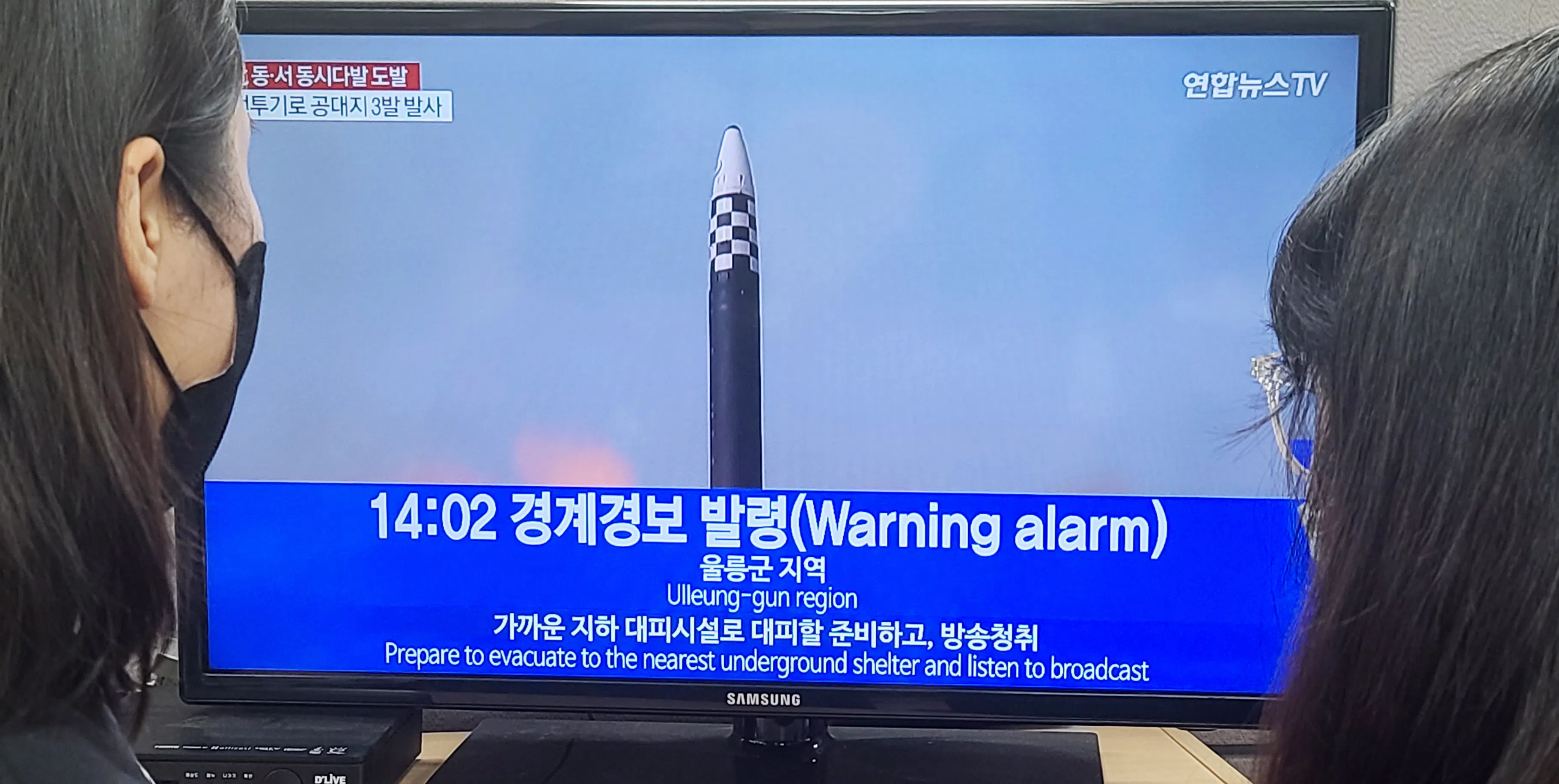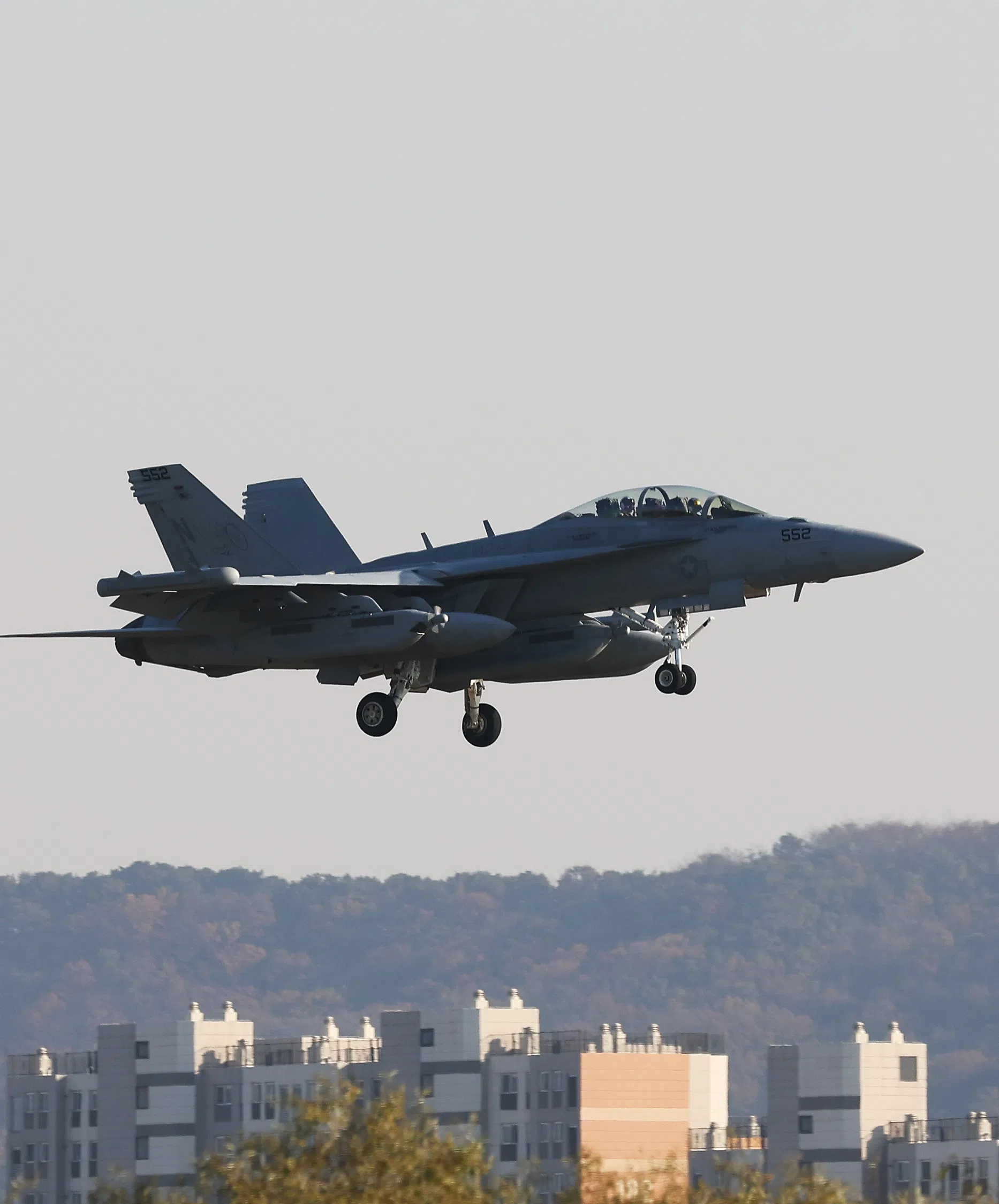North Korea fires 23 missiles, one landing off South Korean coast for first time
Sign up now: Get ST's newsletters delivered to your inbox
Follow topic:
SEOUL - North Korea fired at least 23 missiles into the sea on Wednesday, including one that landed less than 60km off South Korea’s coast, which the South’s President Yoon Suk-yeol described as “territorial encroachment”.
It was the first time a ballistic missile had landed near the South’s waters since the peninsula was divided in 1945, and it was also the most number of missiles fired by the North in a single day.
South Korea issued rare air raid warnings and launched its own missiles in response.
The missile landed outside South Korea’s territorial waters, but south of the Northern Limit Line (NLL), a disputed inter-Korean maritime border.
South Korean warplanes fired three air-to-ground missiles into the sea north across the NLL in response, the South’s military said.
An official said the weapons used included an AGM-84H/K SLAM-ER, which is a US-made “stand-off” precision attack weapon that can fly for up to 270km with a 360kg warhead.
The South’s launches came after Mr Yoon’s office vowed a “swift and firm response”.
“President Yoon Suk-yeol noted North Korea’s provocation today was an effective act of territorial encroachment by a missile intruding the NLL for the first time since (the two Koreas’) division,” his office said in a statement.
When asked whether the missile was flying towards the South’s territory and should have been intercepted, a senior presidential official said: “Strictly speaking, it did not land in our territory but in the Exclusive Economic Zone under our jurisdiction; therefore it was not subject to interception.”
South Korean defence officials said that they were still studying data to determine the types of missiles North Korea had fired, but that at least seven were ballistic missiles.
The Joint Chiefs of Staff (JCS) later said that as many as 14 other missiles of various types had been fired from North Korea’s east and west coasts.
At least one of the missiles landed 26km south of the NLL, 57km from the South Korean city of Sokcho, on the east coast, and 167km from the island of Ulleung, where air raid warnings were issued.
“We heard the siren at around 8.55am and all of us in the building went down to the evacuation place in the basement,” an Ulleung county official told Reuters. “We stayed there until we came upstairs at around 9.15am after hearing that the projectile fell into the high seas.”
A resident on the southern part of the island said they received no warnings.

People watch the news on the lifting of an air raid alarm at an office in Seoul on Nov 2, 2022.
PHOTO: EPA-EFE
The North also fired more than 100 rounds of artillery from its east coast into a military buffer zone established in a military agreement with the South, South Korea’s military said.
The firing violates the 2018 agreement, the JCS said.
Nuclear-armed North Korea has tested a record number of missiles this year, and officials in Seoul and Washington say the North has completed technical preparations to conduct a nuclear weapon test for the first time since 2017.
The launches came just hours after Pyongyang demanded that the United States and South Korea stop large-scale military exercises, saying that such “military rashness and provocation can no longer be tolerated”.
Despite Mr Yoon’s declaring a national week of mourning more than 150 people were killed in a weekend crowd surge
Dubbed Vigilant Storm, the exercises involve hundreds of warplanes from both sides staging mock attacks 24 hours a day.

Major military drills
North Korea had said that a recent flurry of launches was in response to allied drills.
Mr Pak Jong Chon, the secretary of the Central Committee of North Korea’s ruling Workers’ Party, said in a statement on Wednesday that the number of warplanes involved in Vigilant Storm proved the exercise was “aggressive and provocative” and specifically targeted North Korea.
He said even its name imitated the US-led Operation Desert Storm against Iraq in the 1990s.
“The hostile forces’ inordinate moves for military confrontation have created a grave situation on the Korean peninsula,” Mr Pak said in a statement carried by state news agency KCNA.
US State Department spokesman Ned Price on Tuesday said the drills were “purely defensive in nature” and that the US had made clear to North Korea that it harboured no hostile intent towards the country.
Mr Price added that the US and its allies had also made clear there would be “profound costs and profound consequences” if North Korea resumed nuclear testing, which would be a “dangerous, destabilising step”.

A US electronic warfare aircraft EA-18G Growler lands at Osan Air Base in Pyeongtaek, South Korea, on Nov 2, 2022.
PHOTO: EPA-EFE
He did not elaborate on the consequences.
When asked about the missile launch, Chinese Foreign Ministry spokesman Zhao Lijian told a regular briefing in Beijing that safeguarding peace and stability on the peninsula was in everyone’s interest.
“We hope that all parties concerned will stick to the direction of political settlement of the peninsula issue, meet each other halfway, and prevent the situation from escalating,” he said.
On Wednesday, another State Department official said the United States “condemns the DPRK’s ballistic missile launches and its reckless decision to fire a missile below the de facto maritime boundary with the Republic of Korea”.
In a phone call with US Secretary of State Antony Blinken, South Korea’s Foreign Minister Park Jin called the North Korean missile launches “unprecedented” and a “grave act of military provocation”.
The two officials condemned the launch and agreed to cooperate against North Korean threats, Mr Park’s office said in a statement.
Launching missiles in ‘new ways’
South Korea’s Ministry of Land, Infrastructure and Transport said that because of the launches, some air routes over the sea between North Korea and Japan would be closed until Thursday morning.
“Our military can never tolerate this kind of North Korean provocative act, and will strictly and firmly respond under close South Korea-US cooperation,” the JCS said in a news release.
Japan Defence Minister Yasukazu Hamada said the government believed at least two ballistic missiles had been launched from North Korea, one flying east and another south-east.
The first flew 150km to a maximum altitude of approximately 150km, while the second covered a range of 200km to a maximum altitude of 100km, he said to reporters in Tokyo on Wednesday morning.
North Korea’s actions threaten the peace and stability of Japan, the wider region, as well as the broader international community, and are utterly unacceptable, Mr Hamada said.
“North Korea has been repeatedly launching missiles at an unprecedented rate, in new ways that we have not seen before,” he said.
North Korea supplying Russia with artillery shells: US
White House National Security spokesman John Kirby said on Wednesday the US has information that indicates North Korea is covertly supplying Russia with a “significant” number of artillery shells for its war in Ukraine.
Mr Kirby told a virtual briefing that North Korea was attempting to obscure the shipments by funnelling them through countries in the Middle East and North Africa.
“It is not an insignificant number of shells, but we don’t believe they are in such a quantity that they would change the momentum of the war,” Mr Kirby said, adding that Washington would consult with the United Nations on accountability issues over the shipments.
North Korea said in September it had never supplied weapons or ammunition to Russia and has no plans to do so, while warning the US to “keep its mouth shut” and stop circulating rumours aimed at “tarnishing” the country’s image. REUTERS

